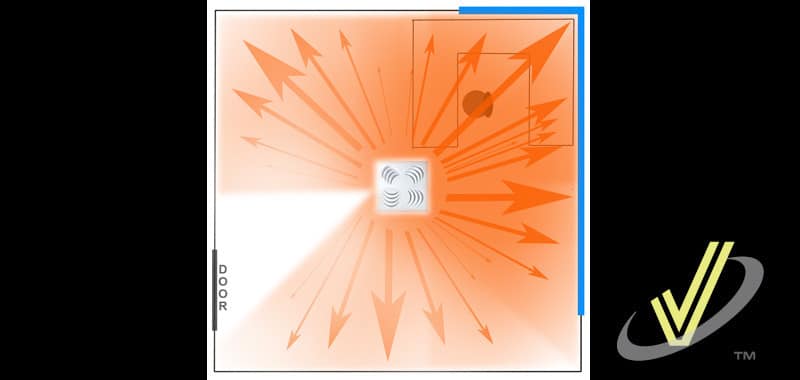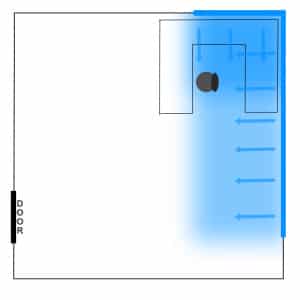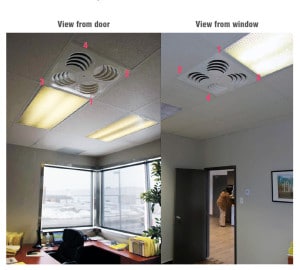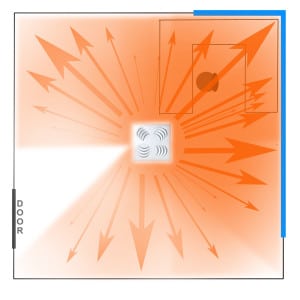
Nous vous présentons ici un exemple simple de comment le diffuseur ajustable PLAY peut permettre une économie d’énergie to en rehaussant le niveau de confort. Cet exemple (en anglais pour l’instant) est pour un bureau fermé individuel mais pourrait aussi s’appliquer à tout autre espace de bureau ou commercial avec fenestration importante ou quelconques autres sources notables de chaud ou de froid.
Voici l’article (en anglais):
In this example, the small closed office has a large corner window – also covering most of one of the walls. In the winter, the large window becomes a considerable source of heat loss and the area around the window feels really cold. The exact opposite happens in hot summer days. In both cases, the result is serious discomfort for the employee.
Click picture to enlarge
This is not fiction; as a matter of fact, it is a real example of an existing building. As we often see in small closed offices, this one had a single standard ceiling diffuser installed in the center of the room. Many solutions were tried to improve the level of comfort; one being the use of zoning and volume control to supply more conditioned air to the room in order to compensate for heat gain or loss. The obvious problem with this solution is that it consumes a lot more energy. Moreover, some of the over-heated or over-cooled air is sent directly throughout the door into an already well-conditioned space. Last but not least, we might end up with a relatively comfortable zone on the right side of the room, but at the expense of the left side of the room now being too cold or too hot.
On top of that, if a thermostat and/or hygrometer are/is located in the office or in the hallway near that door, they (it) may lead to false measurements, hence creating even more discomfort – and waste more energy in the process.
The Solution
In order to efficiently solve that problem, what we really need is to supply more conditioned air concentrated towards the window. Yet we want to supply some conditioned air towards the rest of the room in order to avoid critical stratification and to keep room temperature as even and stable as possible. Ideally, we would rather avoid sending air directly throughout that door. Introducing the PLAY Adjustable Diffuser! The two pictures below show two different views of that office with the PLAY diffuser installed. One picture is taken from the door towards the window and the other one from the window towards the door.
Click picture to enlarge
As you can see, the 4 sectors have been numbered to explain the configuration:
- Sector 1 is directed towards the windowed corner of the room.
- Sector 2 covers the rest of the windowed wall.
- Sector 3 covers the left corner, away from the door.
- Sector 4 covers the back wall, also away from the door.
This illustration – view from above – is worth a thousand words:
Click picture to enlarge
In this example, we have reached the highest possible level of comfort in the most energy efficient way.
The PLAY is the only diffuser which is currently able to achieve this. A one-way, two-way or three-way diffuser would not have supplied air in the room efficiently as the PLAY; furthermore, they would have created stratification zones. Creating an air curtain with linear diffusers in front of the window is also great solution; however, it involves extra ducting and installation, resulting in much higher costs.
The PLAY adjustable diffuser is the easiest, most cost-effective way to achieve optimal results in such applications.
Do you have other examples of great applications you could think of involving the PLAY diffuser, including the PLAY-R Rectangular Diffuser and the PLAY-C Circular Diffuser? We’d love to hear from you! Email us or contact us via Social Medias on Facebook, Twitter, LinkedIn or Google+
Also make sure to watch our videos and subscribe to our YouTube Channel.
Did you like this article? Please share it with your friends and colleagues!






